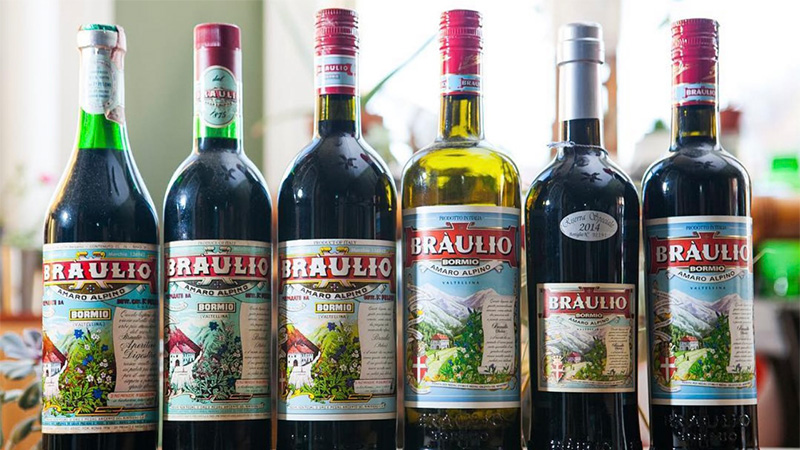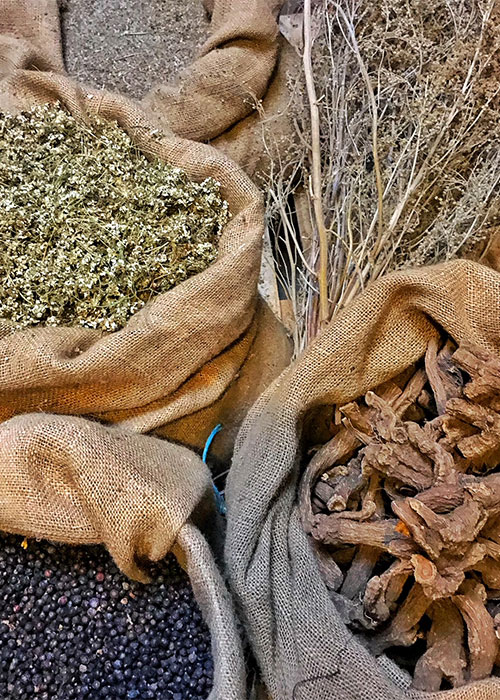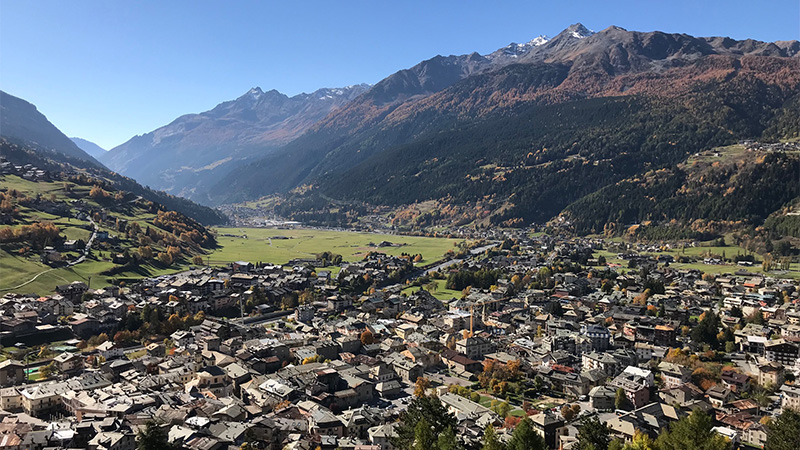As the author of a book about amaro, I’ve spent the past five years conducting numerous talks, tastings, and training sessions on the subject of bittersweet Italian liqueurs. And one of my favorite things to witness is the reaction when people enter the room and are instantly hit with the intense, symphonic aroma emanating from the lineup of amari set up on their tasting mats.
From twisting the cap on the bottle to that first sip, there is no amaro with a greater sense of regional terroir than Bràulio, the iconic alpino-style liqueur from the small mountain town of Bormio in Lombardy’s Valtellina valley on the Swiss border of the Italian Alps. “The most fascinating thing about Bràulio is that it’s probably one of the truest to its name, or its place of origin, of anything you’ll taste in the category,” says Daniel Warrilow, the Italian portfolio ambassador for Campari America. “If you go to where it’s made, the sights, smells, and even the sounds you experience are so unique. And that is so perfectly encapsulated in the bottle.”
I had the opportunity to visit the Bràulio cellars in Bormio in 2017 and can attest to the amaro’s transportive power. When I opened the blinds to the window of my hotel room I was greeted with a vintage postcard-perfect view of endless rows of lush pine trees, rolling green meadows, and snow-capped mountains set against a striking baby blue sky. I didn’t need to squint or rub my eyes to convince myself that I had woken up inside of the scene-setting label from a bottle of Bràulio. (Campari is in the process of rolling out a new bottle design and updated label for Bràulio and Bràulio Riserva. It’s actually quite striking and thankfully maintains the spirit of the iconic mountainside tableau, though I will still be sure to put away a bottle or two of the current Bràulio release for sentimental value.)
Don’t miss a drop!
Get the latest in beer, wine, and cocktail culture sent straight to your inbox.
The Peloni Family Legacy
The story of Bràulio begins in 1826, when Francesco Peloni, a local pharmacist and herbalist who, inspired by the knowledge of the regional flora passed down by his father, Dr. Giuseppe Peloni, created a regionally influenced elixir made with a proprietary blend of locally foraged herbs, roots, and botanicals. Commercial production of Bràulio, which Peloni named after nearby Mount Bràulio, commenced in 1875.
When Gruppo Campari acquired the Sicilian brand Averna in 2014 they also picked up Bràulio, which was in their portfolio, but the production and aging process in Bormio remains a family affair led by master distiller Edoardo Tarantola Peloni and his brother Francesco, both great-grandsons of Francesco Peloni. The recipe remains a secret, with the only four publicly shared botanicals in the blend of 12 to15 ingredients being gentian root, wormwood, yarrow, and juniper, whose aromatic essential oils lend a throughline to Bràulio’s distinctive aroma and flavor profile. After the herbs are harvested and dried, they’re ground up before infusing in a hydro-alcoholic solution in steel drums for several weeks at room temperature. Once filtered, burnt sugar and water are added to sweeten the solution and lower the alcohol content to 21 percent. From there the solution ages in oversized Slavonian oak barrels, which line a maze of underground tunnels in the Bràulio cellars, for up to 15 months to allow all the flavors to mingle and marry together before being bottled in a Campari-owned production facility in Canale d’Alba in Piedmont.

All-Weather Amaro
“Bràulio is such a unique expression in the world of amari,” says Aaron Sing Fox, who co-owns Brooklyn’s Forthave Spirits with Daniel de la Nuez. “We find it to be the standard of the amaro alpino style against which all others are compared. Its unique, cooling pineyness takes the imagination to the herbs growing amongst the majestic mountain peaks of Bormio,” Fox says. “And on the palate, it has a slight spice, notes of cola, bitterness from barks, balanced sweetness, and a long, resiny finish.”
One can drink Bràulio any number of ways: neat, at room temperature; lengthened with a splash of soda water and an orange twist; or as a key ingredient in a cocktail. But despite Bràulio’s après-ski pedigree, it shouldn’t be limited to just cold-weather months. “Because of its aggressive mentholated character, I think Bràulio is a terrific summer amaro. It’s like a cool breeze across the palate,” says Jack Schramm, a Brooklyn-based private bartender and co-founder of the bespoke jelly cake company Solid Wiggles. “My favorite flavor combinations with Bràulio are high acid — I think it can really shine in citrus-forward cocktail applications,” he says. When he was at the now-closed Booker and Dax, Schramm created the Alpine Slide, a slick take on a Bràulio spritz that combines Bràulio, Byrrh quinquina, dry vermouth, and Champagne acid that’s then diluted, chilled, carbonated, and served in an elegant flute. “It was super bright and surprisingly refreshing,” he says. “I love amaro cocktails that turn standard conventions on their head, and I think this is a perfect example.”
The last time I ran into Stephanie Andrews was when I was in Chicago having a late-night bite at the bar at Monteverde. I didn’t see her at the end of the bar, but she made her presence known by sending over a round of Bràulio. “I find Bràulio to be perfectly balanced, herbaceous, lightly bittered, with a touch of spice and slightly sweet,” says the general manager of Billy Sunday Charlotte and the Spindle Bar. “The juniper really reminds me of spring, and I think when summer hits, those flavors really pair perfectly with in-season berries. And then of course when winter hits there is nothing Bràulio doesn’t make sense in.” Two of her favorite cocktails that lean into Bràulio’s herbaceous profile are an amaro Daiquiri that replaces the traditional rum with equal parts Bràulio and the smoky Amaro Sfumato Rabarbaro and a Bràulio Highball topped with a house-made blackberry soda.
Warrilow tends to eschew the classic method of tasting a flight of amari to focus on amaro in cocktails. “I have to look at the lens through how Americans consume beverages and I think cocktails are such an important part of how we can introduce people to these things that they might be very unfamiliar with,” he says. “I love to put Bràulio in a cocktail that somebody can recognize or a variation on a simple classic so that they can see something that looks familiar yet also experience this whole new realm of flavor.” One of his favorites is an equal-parts Whiskey Sour with Bràulio, where the amaro’s piney, juniper notes mingle with a higher-proof bourbon and the frothy mixture of sugar and acid.
Joe Campanale, co-owner of Brooklyn restaurants Fausto and LaLou and author of the forthcoming “Vino: The Essential Guide to Real Italian Wine,” embraces a high-low approach to using Bràulio in drinks that includes bittersweet milkshakes and ice cream floats spiked with the iconic alpine amaro. “I don’t think it makes sense to be too precious with Bràulio, or any amaro for that matter, because here in the States we don’t have a deep history of drinking them and even in Italy amari are sometimes viewed as an old person’s drink,” says Campanale. “Amaro is a complex spirit and it can be used in many more ways other than just drinking it straight up. I think that we’re only at the beginning of the cool things people are going to do with amaro.”

Bràulio Riserva
When Bràulio first became available in the U.S. in the summer of 2013, it quickly became a cult favorite among bartenders and grateful amaro enthusiasts who until then had to sneak back a bottle or two in their luggage. But in Italy, and in some parts of Europe, you can also find Bràulio Riserva, a bottling that has become a top “suitcase bottle” for amaro enthusiasts to add to their collections. This limited-edition, numbered, annual release comes in a 700-milliliter bottle (compared to standard Bràulio’s 1-liter) and features a slightly modified label that also states the vintage. It has a higher ABV (24.7 percent compared to the standard 21 percent), is less filtered, and aged in smaller barrels for up to 24 months, resulting in a much more herbaceous experience. “Having collected the Riserva for years now, as well as vintage Bràulio bottles from the ’60s and ’70s, we find that Riserva is closer to the vintage offerings,” says Forthave Spirits’ Daniel de la Nuez. “It’s deeper and fuller in texture and mouthfeel, more complex and nuanced, less sweet. And as a whole, it’s more integrated in its different aspects of pine, herbs, roots, and spice.”
Seeking out bottles of Bràulio Riserva when I’m in Italy has become a favorite tradition, especially since they’re priced at around 22 euros apiece, much less than what you’ll find on the American secondary market. While you won’t find Riserva sold in any bottle shop in the U.S. (at least for now; there are growing rumors that it will eventually be imported), eagle-eyed fans might spy a bottle on the back bar of amaro-minded venues, likely gifted by a well-traveled regular to their favorite Bràulio-loving bartender. “Bràulio Riserva is even a bit more balanced despite it being higher in alcohol,” says Campanale. “It’s rounded and more full-flavored than the standard Bràulio and since it’s aged in smaller wood containers you pick up more of the oak flavor and since it’s unfiltered it feels more raw and rustic, but I love it.”
Everything Old Is New Again
To attempt to taste a bit of history, the deepest dive one can take into the world of amaro is through vintage bottlings. Most of these date to post-World War II, when the shift from selling amaro in pharmacies in Italy to full-on commercial production was underway. Bottles from the ‘40s and ‘50s are quite rare. Most you’ll encounter are from the ‘60s or ‘70s, and I feel my full-on Gen X age when I see things from the ‘80s and ‘90s considered “vintage.” It’s difficult to find a wide selection of older amari in one place. Most people procure these bottles from estate sales or personal tips, but you’ll uncover some random bottles for sale, typically as part of a larger wine auction acquisition, at bigger, specialized stores like Astor Wines & Spirits or Chambers Street Wines, both located in Manhattan.
Because of its botanical nature and the general presence of sugar, each vintage amaro experience varies. Age and how it was stored are major factors, but so is the variance in flavor and consistency of where and when the botanicals in the mix were sourced. “Amaro will age like wine does, but more slowly because it is higher proof and contains sugar,” says Lindsay Matteson, the bar manager at Barnacle and the Walrus and the Carpenter in Seattle. “Over time the top notes will lessen as well as any bright citrus notes, allowing you to taste more of the secondary and tertiary flavors,” she says. “The body also changes, becoming more velvety, which is really pleasant. And the subtle herbal character will show, allowing for a deeper understanding of the amaro.”
At the Forthave Spirits lab in Brooklyn, Fox and de la Nuez have assembled an impressive collection of vintage amari, liqueurs, and spirits as part of a working reference library to research how various brands and styles of amaro have changed over time. “The intention with our own spirits is that they, too, are age-worthy. So we made choices — such as using all-natural ingredients, avoiding artificial colors and processed sugars, and using natural corks — that, in our experience, is what makes them age well for decades,” says Fox. “We also enjoy them as research tools. There is a deepening of the sweetness and a rounding of the bitterness, the primary high notes are subdued and the finish is lengthened. We love the balance that is sometimes achieved in aged amari.”
For Schramm, the allure of vintage Bràulio remains the “taste of place” of its alpine terroir. “I’m fascinated by the journey a product takes from raw agricultural material to the hand of the maker to a bottle to shelf to dusty basement for a few decades or wherever it ends up. Vintage amaro is a great way to taste this journey.”
If you’re lucky to be able to have a glass of vintage Bràulio it’s a way to look back at the history of the brand and its production methods, but also makes you think ahead to a time long after we’re gone when generations of amaro aficionados might be pouring a flight of Bràulio from the 2010s or 2020s, considering it as “antique.” It’s a reminder of generations of producers behind these storied brands and their legacy that will outlive us all.



